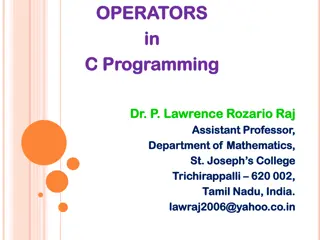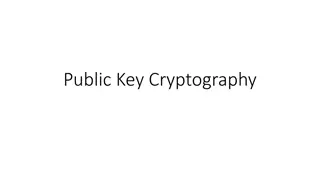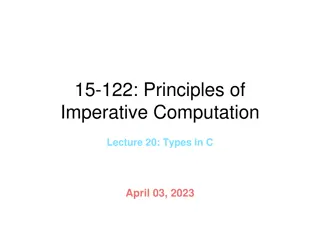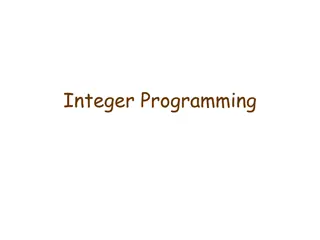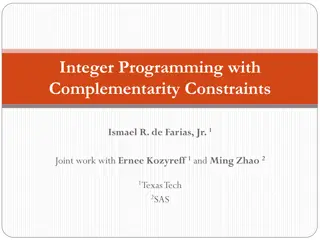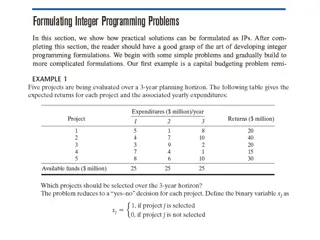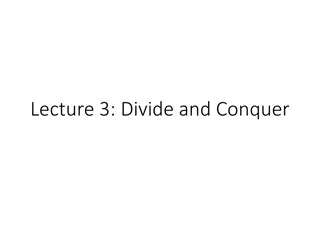Programming in C: Overview and Constants Explanation
Programming in C is a fundamental introductory guide to the C programming language. It covers the basics of C, including its development history, character set, constants, and rules for constructing constants like integer and real constants. Dr. M. A. JAMAL MOHAMED YASEEN ZUBEIR, an Assistant Profes
4 views • 33 slides
Booth's Algorithm for Binary Integer Division
Learn about Booth's Algorithm and how it facilitates binary integer division. Discover key points to remember when using the algorithm, steps to initiate the process, and a detailed example to illustrate the multiplication of two operands using Booth's Algorithm.
2 views • 42 slides
Importance of Using Correct Data Types in Python Programming
Understanding the significance of utilizing the appropriate data types such as string, integer, or float in Python programming is essential for writing efficient code. This content emphasizes the basics of data types, variables, assignment statements, and arithmetic operations in Python. It also hig
1 views • 14 slides
Decision Analysis and Operations Research in Management
This content delves into Management Decision Analysis and Operations Research techniques such as Linear Programming, Integer Linear Programming, Dynamic Programming, Nonlinear Programming, and Network Programming. It covers the phases of an Operations Research study, mathematical modeling for decisi
0 views • 36 slides
Arithmetic Operators in C Programming
C programming language provides various arithmetic operators such as addition, subtraction, multiplication, division, and modulo division. Integer division truncates any fractional part, while modulo division produces the remainder of an integer division. When operands in an arithmetic expression ar
1 views • 18 slides
Overview of MIPS Arithmetic and Logic Instructions in COE 301
MIPS Architecture consists of R-Type and I-Type instruction formats for arithmetic, logical, shift, and immediate constant operations. It includes a variety of general-purpose registers and specific units for execution, floating-point operations, and memory handling. The presentation outlines the st
2 views • 29 slides
Introduction to Public Key Cryptography
Public key cryptography, exemplified by algorithms like Diffie-Hellman and RSA, revolutionizes secure communication by allowing users to encrypt messages with public keys known to all and decrypt them with private keys known only to the intended recipient. This advanced encryption method ensures sec
1 views • 44 slides
Introduction to Mathematical Programming and Optimization Problems
In optimization problems, one aims to maximize or minimize an objective based on input variables subject to constraints. This involves mathematical programming where functions and relationships define the objective and constraints. Linear, integer, and quadratic programs represent different types of
1 views • 25 slides
Multi-Criteria Test Suite Minimization with Integer Nonlinear Programming
The study introduces a method for minimizing test suites using Integer Nonlinear Programming. It addresses regression testing challenges, such as managing large numbers of test cases, through Multi-Criteria Test Suite Minimization (MCTSM). The research explores the application of Integer Programming
1 views • 34 slides
Advances in Integer Linear Programming and Closure Techniques
Explore cutting planes, convex integer programming, Chvátal-Gomory cuts, and closure methods in nonlinear integer programming. Discover how these techniques enhance the efficiency and effectiveness of integer programming models, leading to substantial progress and improved solutions.
1 views • 40 slides
Introduction to Gamma Function and Equivalent Integral Forms
The Gamma function is a versatile mathematical function that generalizes the factorial function to non-integer and complex values. It has various integral definitions such as the Euler-integral form. The proof of the factorial property of the Gamma function is demonstrated through analytical continu
1 views • 20 slides
In-Depth Look at Pentium Processor Features
Explore the advanced features of the Pentium processor, including separate instruction and data caches, dual integer pipelines, superscalar execution, support for multitasking, and more. Learn about its 32-bit architecture, power management capabilities, internal error detection features, and the ef
0 views • 24 slides
Rectangles and Integer Sides: AMC Problem Solving
Analyze a geometric problem involving a rectangle with integer sides and a diagonal stripe. By determining the relationship between the shaded and white areas, conclude the perimeter of the rectangle. Through step-by-step deductions, the solution reveals the rectangle's dimensions and perimeter.
0 views • 5 slides
Introduction to Integer, Char, and Float Data Types
This content introduces the fundamental data types in programming - Integer, Char, and Float. It includes binary representations, images, and related slides. Explore the characteristics and usage of these data types in programming.
1 views • 9 slides
Integer Multiplication with Examples
Explore the concept of multiplying integers with examples of same and different signs. Learn how the product changes based on the signs of the numbers involved. Step-by-step examples demonstrate how to determine whether the result will be positive or negative. Additionally, engage in practical scena
2 views • 14 slides
Solving Misprints: A Problem of Undetected Errors
Two proof-readers are checking a manuscript but find different numbers of errors. When only the errors they both find are compared, it reveals a specific pattern. This challenge prompts an exploration of the likelihood of undetected errors and how to approach similar problems by setting specific int
3 views • 25 slides
Evolution of Integer Sizes in C Programming
The evolution of integer sizes in C programming is explored, from early computers with 8-bit addresses to modern systems with 64-bit pointers. The variations in integer sizes, pointer sizes, and memory capacities over decades are highlighted, showcasing the advancements in computing technology.
0 views • 45 slides
x86-64 Procedures and Data Structures
This content provides insights into x86-64 programming, covering topics such as procedures, integer registers, stack frames, locals in the red zone, interesting features of stack frames, arrays, multi-dimensional structures, and more. It dives into the usage conventions of integer registers, the all
1 views • 44 slides
Integer Sequences and Terms
Explore the concepts of integer sequences, including infinite and finite sequences, terms of a sequence, and nth term formulas. Learn to classify sequences as finite or infinite and find specific terms in a sequence. Gain a comprehensive understanding of notation and terminology used for describing
3 views • 23 slides
Introduction to Integer Programming in Production Planning
Integer programming, a technique rooted in military logistics during WWII, is widely used in various industries due to its ability to model real-life situations efficiently. By formulating problems in a standard form and utilizing algorithms, integer programs can optimize decision-making processes.
0 views • 10 slides
Linear Combinations and Common Divisors Theorem
Exploring the relationship between linear combinations and common divisors through the theorem connecting the greatest common divisor (GCD) and the smallest positive integer linear combination (SPC) of two integers a and b. The theorem states that the GCD is less than or equal to the SPC, with proof
0 views • 45 slides
Data Error Detection Techniques Overview
Two-dimensional parity and Cyclic Redundancy Check (CRC) are data error detection methods used to ensure data integrity during transmission. Two-dimensional parity involves organizing bits in a table to calculate parity bits for data units and columns, while CRC appends a string of zeros to the data
0 views • 20 slides
Computer Arithmetic in Basic Computer Architecture
This presentation delves into the realm of computer arithmetic in basic computer architecture, covering essential topics such as addition, multiplication, division, and floating-point operations. The slides illustrate techniques for integer division and the reduction of division problems, along with
0 views • 58 slides
Integer Division, Modulus, and Parity
Explore the concepts of integer division, modulus, and the parity of integers through the quotient-remainder theorem. Learn how to compute div and mod manually and understand the representation of integers as even or odd. Discover how these principles apply in computer languages and the unique prope
0 views • 18 slides
Integer Programming with Complementarity Constraints by Ismael R. de Farias, Jr.
This work by Ismael R. de Farias, Jr. explores Integer Programming with Complementarity Constraints, focusing on problem definitions, formulations, SOS1 branching, cutting planes, and computational results. The study includes applications in transportation scheduling and map display, along with comp
0 views • 21 slides
Optimization Problem for New Store Placement Decision-Making
A company plans to establish two new stores at different locations to cater to four potential customers. The goal is to minimize total costs, including initial investments, transportation, and inventory costs. Integer linear programming is used to identify the optimal store locations based on constr
0 views • 18 slides
Efficient Algorithms: Divide and Conquer Techniques
Using the Divide and Conquer approach, this lecture discusses strategies for efficiently solving problems such as counting inversions in arrays and integer multiplication. By dividing tasks into smaller subproblems, sorting, merging, and efficiently counting operations, the algorithms presented opti
1 views • 13 slides
Efficient Divide-and-Conquer Algorithms and Applications
Explore the power of divide-and-conquer algorithms through examples like integer arithmetic operations and the Maxima Set Problem. Learn how to improve multiplication efficiency using Karatsuba's algorithm. Understand the concept of maximum points in a set and how divide-and-conquer can efficiently
1 views • 11 slides
Advanced Compression Techniques in Unordered Integer Sequences
Presenting innovative methods for compressing and accessing unordered integer sequences efficiently. Explore fast element extraction and direct addressable variable-length codes to optimize memory usage and enhance data handling. Cutting-edge research from top universities and workshops is showcased
0 views • 8 slides
Practical Implementations of Arithmetic Coding
Explore the practical implementations, advantages, and disadvantages of arithmetic coding in this informative guide. Learn about the basic algorithm, dynamic interval expansion, integer arithmetic coding, and methods to improve the speed of arithmetic coding. Dive deep into encoding algorithms, exam
0 views • 78 slides
Overview of Smalltalk Programming Language
Smalltalk, a pure object-oriented programming language, was initially developed by Alan Kay and further advanced at Xerox PARC. This versatile language features message passing, object-centric design, and a GUI-based system. Explore its classes, methods, class definitions, and more through the Brows
0 views • 17 slides
Implementation of RISC-V in Protium: Overview and Analysis
RISC-V, a royalty-free open-source Instruction Set Architecture (ISA), has gained popularity since its inception in 2010. This article delves into the historical background, extensions, integer registers, and the Pulp platform's RISC-V cores. The implementation of RISC-V in Protium is discussed, pro
0 views • 13 slides
Updates and Enhancements in ERDDAP Version 2.10 by Bob Simons at NOAA NMFS SWFSC ERD Monterey, CA
ERDDAP version 2.10 brings new features and improvements including updated libraries, support for unsigned integer types, revised testing system, enhanced search functionalities, and new visualization options for users. The update addresses challenges such as missing values, and offers better suppor
0 views • 28 slides
Optimization of Multilayer Perceptron Output with ReLU Activation Function Using MIP Approach
This research focuses on developing a systematic optimization model that incorporates a ReLU activation function-based neural network as input. The model generates a linear output that can be modeled as MILP and solved using a Mixed-Integer Programming approach. By producing scalable surrogate model
1 views • 7 slides
Train Unit Scheduling Study: Optimal Capacity Management Approach
This study focuses on optimizing train unit scheduling by satisfying capacity requirements and minimizing operating costs. The research addresses imbalanced demands and under-utilized train units, proposing solutions for re-balancing. It explores integer multicommodity flow representation and method
0 views • 33 slides
Computer Arithmetic: ALU, Integer Representation, and Twos Complement
Exploring the fundamental concepts of computer arithmetic including the Arithmetic & Logic Unit (ALU), integer representation methods, and the Twos Complement system. Learn about sign-magnitude, characteristics of Twos Complement representation, benefits, negation techniques, and special cases in co
1 views • 57 slides
Key Concepts in AP Computer Science A Exam Review
Essential topics covered in AP Computer Science A Exam include identifiers, primitive data types, number representation, final variables, and arithmetic operators. Recognizing the basics, such as types, identifiers, operators, and control structures, is crucial for success in the exam. Understanding
0 views • 100 slides
Constants and Literals in C++ Programming
Constants and literals in C++ are fixed values that the program cannot alter. They come in various types such as integer numerals, floating-point numerals, characters, strings, and boolean values. Integer literals can be decimal, octal, or hexadecimal constants, while floating-point literals have in
0 views • 7 slides
Combinatorial Optimization in Integer Programming and Set-Cover Problems
Explore various combinatorial optimization problems such as Integer Programming, TSP, Knapsack, Set-Cover, and more. Understand concepts like 3-Dimensional Matching, SAT, and how Greedy Algorithms play a role. Delve into NP-Hard problems like Set-Cover and analyze the outcomes of Greedy Algorithm se
0 views • 60 slides
Integer-Valued Zero Autocorrelation Sequences
Delve into the realm of integer-valued zero autocorrelation sequences, exploring concepts like periodic sequences, frequency domains, constant amplitudes, and more. Unravel the methods and techniques involved in creating these sequences and their significance in various applications.
0 views • 32 slides




